Fall Foliage and Connecticut River Trout
Welcome the fall with leaf peeping and trout fishing in Pittsburg, New Hampshire.
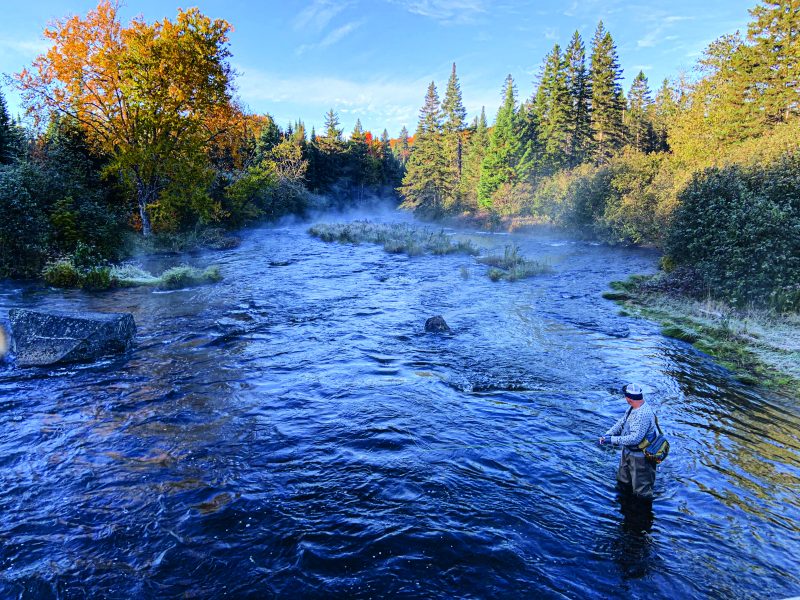
I stepped carefully into the icy current and waded slowly toward the middle of the river. There was a heavy fog over the water, so I couldn’t see to the other side. As I started to pull line off my reel to make a cast, it felt like I was fishing inside a cloud. The visibility would have been more troublesome if I hadn’t stood in exactly this spot the evening before. I already knew about the deep, slow pool just across the river, where the water pushed and gurgled its way around and through the giant root ball of a fallen tree. On one of my last casts of the evening, a heavy thump and flash in the water as a fish hit my streamer told me the pool held nice fish.
The water was high. The strong current being released from the dam upstream crept up into the grass and small trees at the bank; unlike the day before, the river this morning was full of leaves. They floated at the surface, but also rode the current downstream in an even distribution from top to bottom, forming a sort of “leaf soup,” then collected in little piles where the river pushed against rocks and logs.
I didn’t see any reason to change flies. The day before, it had produced a couple of landlocked salmon and a brook trout before I lost the fish in this pool, so I confidently swung the Black Ghost through the water as I tried to make the same length cast. My senses still felt heightened from the strike the evening before, so I lifted the rod quickly when I felt a solid tap when the fly swung through the sweet spot on my first cast.
“Damn! Missed it!”
I made a new cast and swung the fly again. Tap, tap! Another swing and a miss. This happened several times until after yet another hit, I checked my fly to find a freshly fallen leaf firmly attached to the hook’s bend. I guess I hadn’t missed the hookset after all.
As I realized I probably hadn’t had gotten any hits at all and was simply snagging leaves with each swing, the fog began to burn off and I could now make out the large fallen tree across the river. As the sun came up, I moved further downstream and a little deeper into the icy water. I crept forward as far as I dared and made a cast right up against the curly wooden roots that threatened to steal my fly. The sun was bright now and I could see well into the clear water. Instead of swinging the fly, I stripped it quickly away from the wood and over a deeper section where I couldn’t see the bottom. Immediately, a long fish rose from the depths and grabbed the fly. The heavy throbbing as the fish shook its head lasted for only a moment before the line went slack. I probably shouldn’t put in writing what I said next. It can be easy to mistake a leaf for a fish, but much less likely to mistake a fish for a leaf.
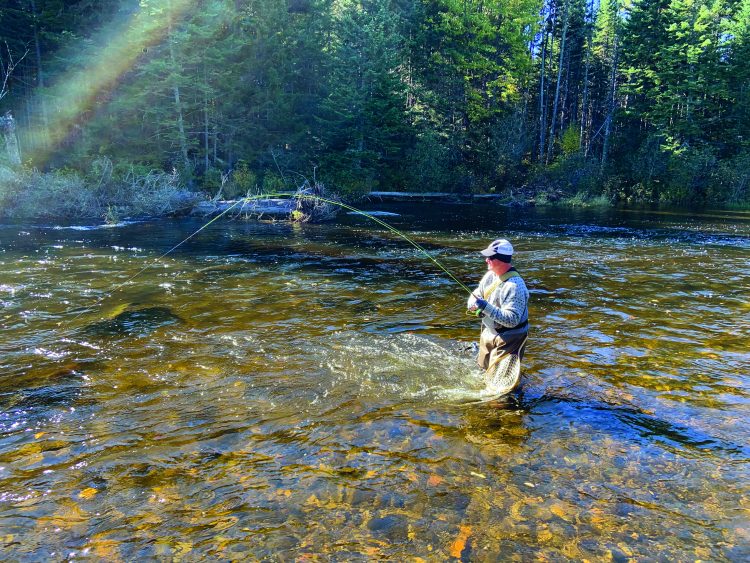
The season’s first blast of cold autumn air found my friend, Shreve, and me watching the sunrise through the car window as we cruised along the Canadian border on the way north from our homes in southern Vermont and New Hampshire. We could see Canada to our left, and a few border patrol trucks passed us going in the opposite direction. Frost glinted in the sunlight where it coated the grasses along the roadside and the marshy areas, where I had my eyes peeled for a moose.
Our destination was Pittsburg, New Hampshire, one of the few outposts of civilization in an area commonly referred to as “The Great North Woods.” The headwaters of the mighty Connecticut River begin as a trickle not far from there. It flows south through wild boreal forest and passes through several lakes and dams, creating some of the finest trout and salmon fly fishing in the east. Brook, rainbow, and brown trout all thrive in the river, and in the spring and fall, landlocked salmon move out of the lakes and into the river to chase baitfish and spawn.

The first day on the river, we fished the stretch between First and Second Connecticut Lakes, where the regulations are Fly Fishing Only and Catch And Release. We carefully traveled rough paths along the river with fly rods through the aromatic spruce forest to explore what felt like untouched water. I caught a salmon about 14 inches long, then a small brook trout with bright red spots on its side that were the color of the changing autumn leaves. Later, a larger salmon about 17 inches long hit my Black Ghost streamer and flashed a copper hue in the tannin-stained water as I brought it into the net.
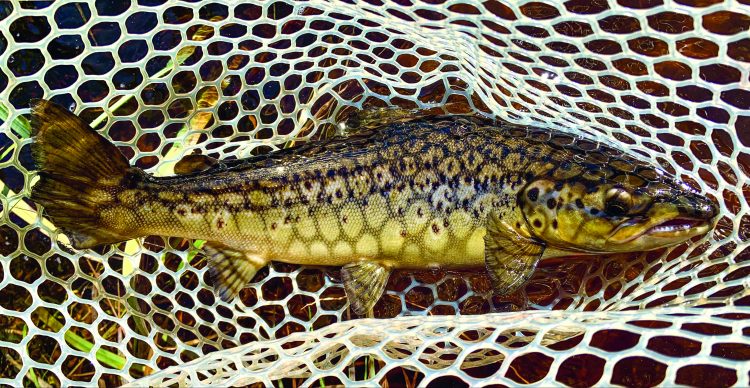
We saw very few fishermen, but the logging roads were busy with traffic from both bird hunters and leaf-peepers. Trucks with folks wearing blaze orange and hauling dog kennels in the back passed back and forth like a hunting parade. Later, as I fished my way back to our vehicle, I was swinging a fly into the pool under the bridge where we’d parked. A large SUV stopped on the bridge, and a woman climbed out with a camera and a lens the size of a fire extinguisher. I tried not to hook any branches on my back-cast as she snapped photos of the river and brightly colored foliage that I’m pretty sure included me. I was glad I had bought new waders for the trip and wasn’t wearing the old ones with patches of Gorilla tape along the thigh.
The dams were releasing a lot of water. In the summer, it provides essential cold water for trout, but on this trip, it left us searching for comfortable flows to effectively fish. We tried a stream that drained out of a smaller lake, and while the water level was good, we didn’t find any active fish. As we looked around at the lake and dam at the start of this stretch, we were approached by some birds that had no fear of us. They were Canadian Jays and looked like blue jays but without the bright blue color. They are a northern bird, and this was the very southern end of their range. They are not shy, and while holding a few nuts, Shreve was able to get the birds to land and eat out of his hand. We also saw a coyote cross the road carrying its next meal in its mouth and spotted an otter working its way along the water’s edge as we cast from the opposite shore. Sadly, I still hadn’t spotted a moose.
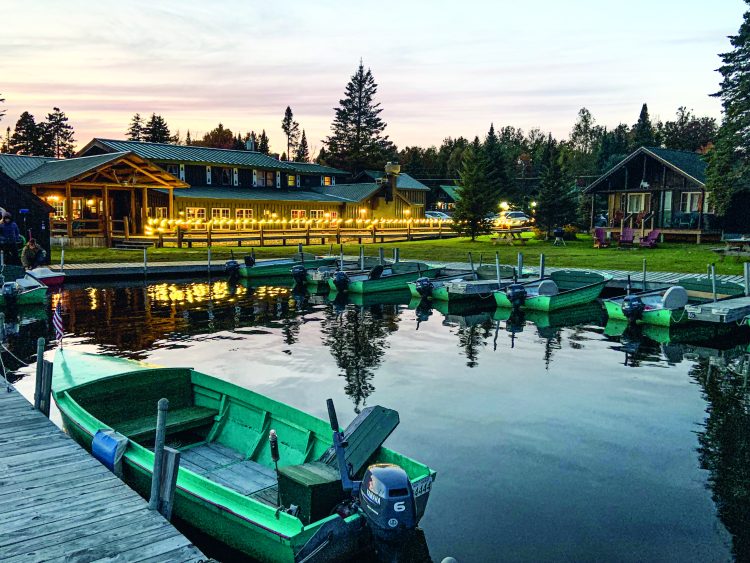
Tall Timbers Lodge is located on the shore of Back Lake in Pittsburg, where they have a large dock and a fleet of fishing boats tied up out front. As I took some pictures of the sunset, a few fishermen cast from a boat on the calm waters of the lake as the air cooled to where you could begin to see your breath. The lobby made me feel like I was a guest in somebody’s home. The cozy living room, with comfortable furniture and a woodstove, had mounted deer heads and fish on the walls. There was plenty to look at while we waited for our table in the tavern, where I enjoyed what was perhaps the fanciest meal I have ever eaten while on a fishing trip. When I woke up at 5 a.m. the next morning, the pot in the common area outside our room was already full of fresh, hot coffee.
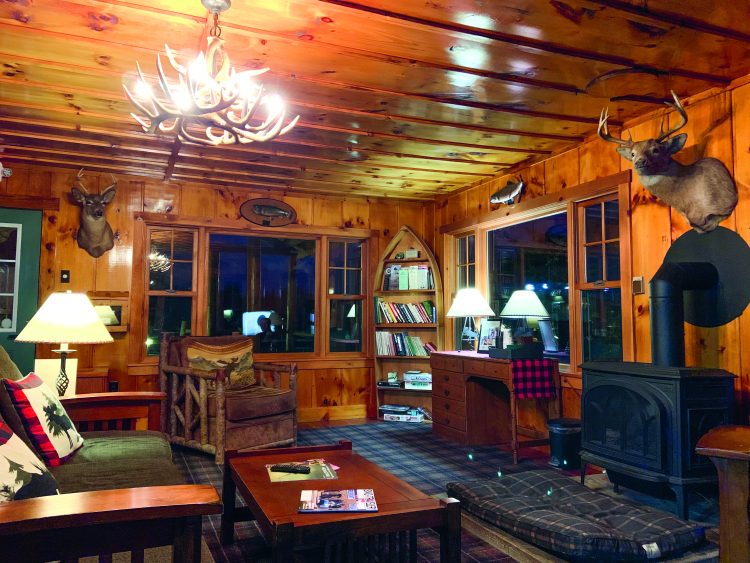
We didn’t have an ice scraper, so we sat in the car with the defroster on high for several minutes before the frost on the windshield cleared enough to drive to the river. The well-known “Trophy Stretch” of the Upper Connecticut River, between Lake Francis and First Connecticut Lake, is a great place to fish because it has some big fish and good access. It can also be a tough place to fish, precisely because it has some big fish and good access. The lot was nearly empty on this Monday morning, though, compared to the day before, and we took a few swings with our flies through the pool at the bridge, sensibly named the “Bridge Pool.”
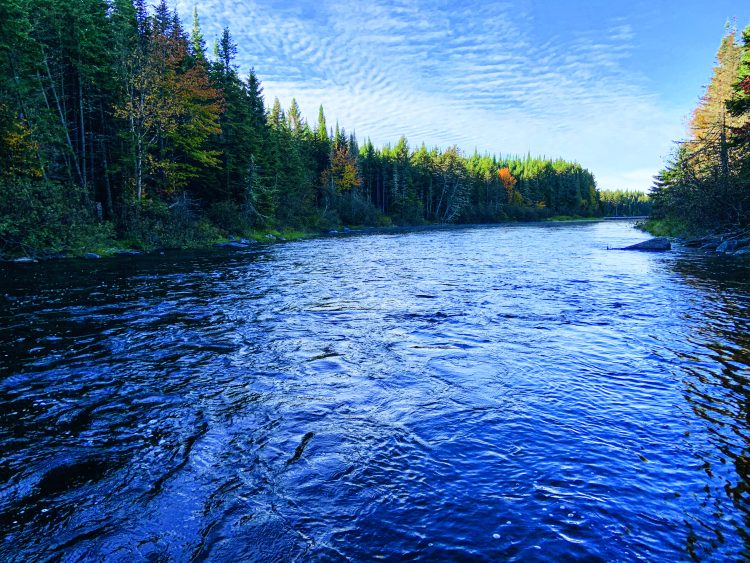
A heavy fog hovered over the water and white frost clung to the branches and grass like a beer mug fresh out of the freezer. It was cold, and a little bit of ice began forming in my guides, reminding me of steelhead fishing. We worked our way downstream, excited to have more time to explore than the evening before. After losing the fish at the fallen tree, I pushed further downstream, though the woods were thick and challenging to hike through with a fly rod. The faint trail eventually disappeared, so continuing required careful threading of my rod tip between trees and branches. It sometimes got stuck and I needed to slowly back up and try again, though after a few hundred yards, there were few signs of other people. The high water made it tricky, but I found a couple places with some deeper holding water where I was able to present my fly, eagerly anticipating another fish to emerge from the depths and take a swipe at my streamer. Unfortunately, I didn’t have any more hits, but the sun felt warm, so I peeled off some layers. It felt great to be in the fall woods. The sight of brilliant, falling leaves filtering the sunlight with the combined smell of the river and the woods gave me a sense of contentment I can’t seem to find anywhere else.
Working back upstream, I found Shreve fishing the pool with the fallen tree, and I told him about the fish that I had hooked and lost twice now. He had been doing well with a nymph and had landed a couple of nice trout. As I watched him from the bank, he hooked another beautiful wild rainbow from the pool, and we admired its pink, metallic hue shining in the sun for a moment before he released it.

After meeting at the car for a lunch break, where we had to protect our food from the hovering jays looking for a free meal, I explored upstream for the afternoon. There was a well-defined trail, and even though it passed through some deep mud and standing water, it was easier traveling than where I had gone that morning. There were a few more fishermen now, but I was able to fish a few spots as I pushed upstream. It was still a pretty fast current, with a lot of leaves in the water. As I tried one promising-looking section of pocket water, another fisherman walked by and told me he had caught a 16-inch rainbow in that very spot only 30 minutes before. After he walked away, I finally decided to try a different fly and fished the water a little harder.
Later in the afternoon, nearing the time we had to head for home, I was walking back downstream toward the car. I passed a guy nymphing with an indicator in a deep slot that pushed up against a large boulder. I had eyed the spot earlier and thought about stopping to fish it on the way back. The bright indicator floated quickly downstream in the fast current before he had to lift the line and flip it upstream again.
“Catch anything?” I yelled over the roar of rushing water. He looked back at me over his shoulder, and with a big smile replied, “Just a bunch of leaves!”
Related Content
How to Find and Catch Brook Trout
Guide Tactics for Tough Trout: Nymphing
WATCH: Brook Trout and Landlocked Salmon in Pittsburg, NH – OTW’s Angling Adventures S13 Ep. 7
2 on “Fall Foliage and Connecticut River Trout”
-
Colin Drane If anyone is interested in fishing up that with a guide Mickey Cunliffe is a top notch option. You can find him on FB Fishing with Mickey. Great guy and better fisherman. Used him multiple times and couldn’t have been happier with the results.
-
Ken Hastings I guided and lived on the upper Connecticut for forty years. One rule of thumb fishing the ‘Trophy Section ‘, the higher the water the bigger the number of good fish there. Fishing it @ 700 CFS produced some great salmon but limited the wading for sure. Enjoy the gem of my memories.
Leave a Reply